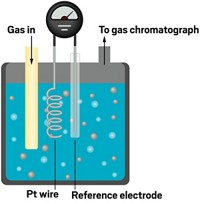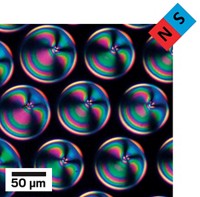Advertisement
Grab your lab coat. Let's get started
Welcome!
Welcome!
Create an account below to get 6 C&EN articles per month, receive newsletters and more - all free.
It seems this is your first time logging in online. Please enter the following information to continue.
As an ACS member you automatically get access to this site. All we need is few more details to create your reading experience.
Not you? Sign in with a different account.
Not you? Sign in with a different account.
ERROR 1
ERROR 1
ERROR 2
ERROR 2
ERROR 2
ERROR 2
ERROR 2
Password and Confirm password must match.
If you have an ACS member number, please enter it here so we can link this account to your membership. (optional)
ERROR 2
ACS values your privacy. By submitting your information, you are gaining access to C&EN and subscribing to our weekly newsletter. We use the information you provide to make your reading experience better, and we will never sell your data to third party members.
Materials
The Mystery Of Hot Gold Nanoparticles
An unintended route to magnetism may lead to thermal cancer treatment
by Mitch Jacoby
April 1, 2013
| A version of this story appeared in
Volume 91, Issue 13

One of the hottest potential applications of metal nanoparticles is the thermal treatment of tumors. In response to various forms of radiation, nanosized specks of metal, especially gold, can get hot enough to damage cancerous tissue.
One strategy to heat the particles exploits radio-frequency waves. RF radiation hardly interacts with biological tissues and therefore offers the advantage of penetrating more deeply than laser radiation, an alternative strategy under evaluation in human clinical trials. And compared with radiation therapy, the effects of thermal treatments may be better confined to the diseased region.
But although scientists have seen gold nanoparticles get hot after RF exposure, they’ve struggled to explain why this happens. Some researchers have shown theoretically that one proposed mechanism or another cannot be the basis of RF heating. Others have weighed in with experimental results. But the lab results appeared contradictory. Until the heating mechanism is understood, nanoparticle temperature will be hard to control and it will be difficult to advance this kind of cancer treatment. So the conflicting findings have sparked a vigorous debate.
To sort through the arguments, a group led by Christopher J. Ackerson, an assistant chemistry professor at Colorado State University, Fort Collins, has carried out a series of control tests. The study, which addresses the range of variables at the source of the confusion, appears to resolve the seemingly contradictory findings and points to an explanation: Heating seems to occur through an unexpected magnetic mechanism.
Gold nanoparticles’ biocompatibility and chemical stability make them attractive agents for using heat to destroy tumors. Various synthesis methods can be used to add molecular features to the surfaces of the particles such that they selectively “seek” tumor cells. And unlike anticancer agents used for chemotherapy, the particles remain harmless until they are activated.
A few years ago, a number of research groups reported that the gold particles can be readily heated by exposing them to RF waves, the low-energy radiation used for cell phone communication. Researchers attributed the observed temperature rise to so-called joule-type heating. The idea is that the interaction of RF waves with electrons confined in nanosized bits of metal induces electric current flows. These induced eddy currents in turn stimulate resistive heating.
But that mechanistic explanation touched off the debate. Other researchers argued that joule-type heating wasn’t the basis of the temperature rise and that heating was instead caused by salts in solutions containing the nanoparticles. The solutions often contain residual salts that are carried over from nanoparticle synthesis, and their interaction with RF waves could cause heating. That argument seemed plausible: RF waves can heat salt solutions that are free of nanoparticles.
Still other researchers countered that argument. For example, in 2012 a team led by researchers at the University of Texas, Houston, and Rice University showed in an experiment that highly purified salt-free solutions of relatively small gold nanoparticles (<10 nm) heat up in response to RF radiation (J. Phys. Chem. C, DOI: 10.1021/jp309053z).
That finding thickened the plot. If joule-type heating might not be occurring and residual ions in the nanoparticle solutions had nothing to do with the heating, how else could RF waves heat the nanoparticles?
Other RF heating mechanisms were known, but they didn’t seem relevant to particles of gold. For example, unlike joule-type heating, which describes the behavior of nonmagnetic metal particles, RF heating of magnetic nanoparticles such as iron oxide is well-known. In that case, heating results from a kind of friction induced by an oscillating magnetic field, which causes magnetic particles to rotate rapidly in the solvent. A related magnetic heating mechanism involves rapid flipping and realignment of the particles’ magnetic moments. But because gold nanoparticles are not magnetic, these magnetic heating mechanisms seemed unrelated to the story.
As this debate was playing out, Ackerson was puzzling over the results of his group’s first sets of experiments in this area. He and his coworkers found that they were unable to reliably heat gold nanoparticle solutions in an oscillating RF magnetic field. (The electric and magnetic components of RF radiation can be separated easily.) “Sometimes the heating worked well; other times it didn’t,” he recalls.
Fully aware of the RF magnetic heating mechanisms, Ackerson wondered whether the irreproducibility was caused by unexpected magnetism in his gold particles. Perhaps the particles became magnetic as a result of an unintended reaction. For example, the particles may have become oxidized unintentionally by atmospheric oxygen, which his group did not deliberately exclude during nanoparticle synthesis. Or perhaps the standard reduction step used to synthesize these nanoparticles did not thoroughly reduce the particles but instead left some in an oxidized, and therefore possibly magnetic, state.
To test that hunch and pin down the gold particle heating mechanism, Ackerson’s group carried out a series of experiments that minimized variation in particle size, composition and purity of solution, and other variables that confounded this field’s earlier experiments. The team, which includes Ruthanne S. McCoy, Sam Choi, and coworkers, prepared samples of 102-atom gold clusters capped with p-mercaptobenzoic acid, a stabilizing ligand. These Au102 clusters are known as magic-number superatoms because they have a noble-gas-like closed-shell electron configuration. The aim of using these highly controlled structures was to determine if an oxidation reaction could alter the electron configuration and thereby make the particle magnetic, specifically paramagnetic.
That’s exactly what happens. On the basis of nuclear magnetic resonance measurements and other analyses, the team finds that treating the Au102 clusters with KMnO4 oxidizes the particles, alters their electron configuration, and renders them magnetic. Among other findings, the team also reports that RF waves consistently heat the oxidized gold particles and that the heating rate depends on the extent to which the samples of particles are oxidized (ACS Nano, DOI: 10.1021/nn306015c).
The results indicate that RF heating of gold nanoparticles results from mechanisms based on magnetism. The investigation also suggests that in some of the earlier studies, researchers may have unknowingly been working with magnetic gold particles, which would account for the heating.
“This is a very interesting paper,” says Massachusetts Institute of Technology’s Kimberly Hamad-Schifferli, whose group published one of the early RF heating studies. By carefully controlling the size of the cluster and its oxidation, Ackerson’s group has done a nice job showing that gold nanoparticles’ magnetic properties are responsible for RF field heating, she says.
Florida State University’s Kenneth L. Knappenberger Jr. agrees. Ackerson’s work on electronically stabilized nanostructures “represents a breakthrough,” he says. “This level of structural control could pave the way for reliable therapeutic applications of nanoclusters.”




Join the conversation
Contact the reporter
Submit a Letter to the Editor for publication
Engage with us on Twitter